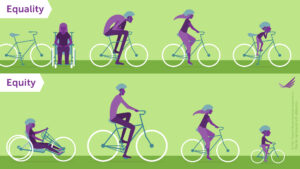Getting Started with Equity-Focused Teaching (EfT)
Below are some resources CRLT-Engin generated to support Michigan Engineering instructors in getting started with equity-focused teaching (EfT).
Understanding Equity
What is equity?
To begin with equity-focused teaching (EfT), it is necessary to first understand the concept of equity. Equity is often confused with the concept of equality, however the two are not the same! Let’s begin by differentiating between these two terms.
- Equality: Referring to everyone getting the exact same tools, resources, and opportunities regardless of need; a “one size fits all” mentality.
- Equity:
- At the most basic level, equity refers to recognizing and acknowledging systemic inequities (e.g. racism, sexism, ableism) and the negative impact they have on marginalized and minoritized communities. Within the context of a classroom, this means understanding that due to systemic inequities and the diverse range of backgrounds and experiences, not all students are starting from the same place when they enter your classroom and require different supports to navigate and complete your course. Striving for equity means providing students with the specific tools, resources, and support they need to navigate and pass your course, which may differ from student to student.
- However, striving for equity goes beyond just recognizing and acknowledging systemic inequities and providing individuals with the needed resources. It is also about understanding how prevalent these inequities are in society, education, and (as engineers) STEM, and how they are perpetuated through the cultural norms and values of those spaces, which individuals from marginalized and minoritized communities are often asked to assimilate to. It means thinking critically about how the culture of these spaces must change to create a more just and equitable society.
- Visualize the Difference: This image is a great example of how equity and equality differ. In the top half of the image, every person received the same bike. Unfortunately, that bike did not work for everyone – some couldn’t even ride the bike! An example of a systemic inequity in this part of the image is the concept of ableism. The bike was not designed for a disabled individual (i.e. a wheelchair user) – only able-bodied individuals. In the bottom half of the image, every person gets a bike suited to their needs, including a bike designed for wheelchair users, which allows all of them to successfully ride. The bottom half of this image is an example of equity in practice!

Visualizing Health Equity: One Size Does Not Fit All Infographic by RWJF on RWJF.org
*Definitions to the underlined terms can be found here.
What does equity-focused teaching (EfT) look like?
- Recognizing that systemic inequities contribute to the educational disparities often most experienced by minoritized and marginalized students.
- Understanding that these inequities shape all students’ personal and academic experiences, impacting their learning and academic success.
- Being purposeful in cultivating a classroom environment that is responsive to the impact of systemic inequities in teaching and learning so that students:
- Have equal access to learning
- Feel valued and supported in their learning
- Are able to achieve positive course outcomes
- Shifting away from viewing students through a deficit-model lens (see reflection sheets linked below for more on this).
- Utilizing an asset-based teaching approach that recognizes and incorporates the strengths that students bring with them into the classroom (see reflection sheets linked below for more on this).
- Practicing EfT is a continuous learning process. Being introduced to challenging concepts, understanding them, and applying that knowledge in your teaching, requires daily practice, self-reflection, and support. CRLT-Engin consultants are always available to support instructors with this process.
*Definitions to the underlined terms can be found here.
Self-Reflection
What is self-reflection and why does it matter?
Equity-focused teaching (EfT) begins with self-reflection. This refers to the process of examining your own background, identities, and life experiences. These influence your actions, beliefs, and perceptions and expectations of others – such as your students. As an instructor, self-reflection is a tool that can help you identify how your teaching practices and classroom policies unknowingly perpetuate systemic inequities.
Self-reflection tools
Below are some resources to help get you started on the process of self-reflection and equity-focused teaching (Eft).
U-M Resource: Anti-racism Primer
For More Learning
Equity-focused resources
If you are interested in gaining a deeper understanding of equity-related topics in STEM, CRLT-Engin has compiled a list of resources (found at the link below). Resources include articles, documentaries, podcasts, and book chapters. If you come across items you’d like to add, or have ideas on additional resources you’d like to see, please email us at <[email protected]>.
-
- Visit Equity-Focused Resources page.
